Thursday, 8 December 2016
Making Putiputi
Follow this link to find instructions for making PutiputiMaking Putiputi
Sunday, 27 November 2016
Science Alive
WACKY WHEELS
 |
| Science Alive at Papanui Library |
 |
| Focused on our car design |
 |
| Colouring the car |
Preparing to cut out the car
 |
| Happy with how my car looks |
 |
| Adding the wheels to the axle |
Tuesday, 22 November 2016
Summertime Reading Club - Details coming soon!!
In conjunction with the Christchurch City Public Libraries there is a fantastic opportunity for our students . . . .
Starts 16 December 2016 - 31 January 2017

Starts 16 December 2016 - 31 January 2017

Monday, 21 November 2016
Gathering Harakeke
Gathering Flax
Where to find flax
Flax
grows plentifully in most parts of New Zealand. To find a source of flax for
weaving, check for bushes growing in your own or friends’ gardens, or contact
your local council or local Māori representatives, or iwi, for
permission to gather flax in public places. For permission to gather flax in
public places in Christchurch contact the Christchurch City Council.
Which species to use
There are two species of native New Zealand flax —
Phormium
tenax and Phormium cookianum.
Phormium tenax: Harakeke
The
main flax used for weaving is Phormium tenax, or harakeke, a
lowland or swamp flax. It can be distinguished from Phormium cookianum
by its deep red flowers, its seed pods which are thick and straight and the
fact that its leaves, flowers and seed pods all point upwards. There are many
different varieties of harakeke, all with different leaf qualities — the leaves
can be long or short, and can have long fibre or very little fibre, and this
variation results in different varieties being used for different weaving
projects.
Illustrations
of sixty-three weaving varieties are accessible from Landcare’s Harakeke weaving varieties page and
descriptions of these varieties are also included in the booklet "Harakeke: The Renee Orchiston Collection" which is
available in hard copy or as a PDF file from the Landcare website.
Phormium cookianum: Wharariki
Phormium
cookianum, or wharariki, is a coastal or mountain flax, and is not
generally used for weaving. It has softer leaves which bend over and outwards
and which feel thinner than Phormium tenax leaves. The yellow or orange
flowers point upwards but the thin, twisted seed pods droop downwards.
Wharariki
can be used for smaller items, including woven flowers and can be a good choice
for beginners or children as the softness makes it easier to work with. It is
not suitable for larger or more intricate items as it can split easily and
doesn't have the durability of Phormium tenax.
Coloured flaxes
There
are many coloured flax varieties ranging in colour from deep reds to yellow and
soft green. Most varieties are variegated, and each variety can have a wide
range of colours in its leaves.
Coloured
flaxes are not usually used for weaving, although they can be used for smaller
items such as woven flowers, or can be added as a feature to other weaving.
The
colours will fade as the flax dries, with the deep red and yellow colours
fading out to paler, more muted colours. Coloured flaxes are great to use for
making a fresh bouquet of woven flowers.
Māori protocol
The
weaving of flax follows a long and rich tradition established by Māori, the
indigenous people of New Zealand. Māori tradition includes a protocol, or tikanga,
that covers both harvesting and weaving flax. I’m not able to speak on behalf
of this tradition, as I have no Māori ancestry, but I think it’s important to
respect the protocol. This protocol can vary slightly in different parts of the
country but here is my understanding of the most widely accepted protocol:-
Before
harvesting the flax, a prayer of thanks may be said. When harvesting flax, the
central shoot of each fan of leaves, or rito, is not cut, nor are the
two leaves, the awhi rito, on either side (see instructions and photo
further down on this page). The outer leaves are cut in a downward motion as
close to the base of the leaf as possible. (This will keep the flax plant
healthy and it will keep growing, so that it can be harvested again.) Flax is
not cut at night or in the rain or snow and only enough flax is cut to complete
the weaving project. Traditionally, flax is not cut by women who are
menstruating, but I understand that — in light of changing views on women's
health — this protocol is no longer observed by everyone. The cut flax is not
stepped on or over and food and drink are kept away from the weaving area.
Hands are washed after weaving and before eating. (If you don’t, you’ll soon
learn that even a small quantity of the sap from freshly-harvested flax is
highly laxative!) When the weaving is finished, discarded pieces of flax are
not burnt but returned to the ground to rot. Traditionally it was returned to
the ground underneath the flax plant it was cut from, but now it is often
recommended that waste flax is returned to the ground some way from the flax plants
to avoid setting up conditions conducive to disease. Weaving projects that have
been started are finished and the first weaving project a person completes is
given away.
Selecting the leaves
As
it is often difficult to know which variety of Phormium tenax you are
cutting, and therefore what uses it is best suited for, you will need to select
the leaves with the characteristics required for your weaving project.
Softer,
thinner leaves with a shorter useable weaving strip, up to about 50cm in
length, are good for smaller items. Larger items require thicker, stronger
leaves and longer strips, although the leaves should still be soft enough to
weave with.
If
your weaving project starts with a fibre plait where all the new strips are
added one by one by plaiting in the fibre end on the strip, then the leaves
will need to have a long fibre length. To check for length of fibre in the
leaf, use the technique for making fibre ends.Finally,
check that the leaves are not damaged by pests and diseases as you cut.
Cutting the flax
The
leaves on the flax plant grow in separate fans with 2-14 leaves fanning out
from a central new leaf. Leave this central leaf and the leaf each side of it
so that the flax plant can keep growing. Cut the leaves on either side of these
three central leaves, in a downward angle, away from the plant, and as close to
the base of the leaf as possible. In this way, water can’t run into the centre
of the plant and rot it.
When
you have cut the leaves for your project, tie them together in bundles, keeping
the leaves from each bush together. If possible, it's best to use leaves from
the same bush in one piece of weaving. Before leaving, cut away any dead or
diseased leaves from the plant to encourage new growth and to help keep the
plant healthy.
How many leaves to cut
To
work out how many leaves to cut, first decide on the width of the weaving
strips and how large the item will be that you are weaving. Smaller items look
better in strips with smaller widths, such as half a centimetre to one
centimetre, and larger items can be made with greater widths, up to one and a
half centimetres wide.
Next
decide how many strips the majority of leaves on your flax plant will provide,
and determine the number of leaves to be cut by dividing the number of strips
each leaf will provide into the number of strips required for the article,
allowing a few extra leaves for good measure.
Storing the cut flax
Flax
can be woven immediately, stored for two to three weeks before weaving, or
boiled for long-term storage. It’s best to weave flax when it is neither too
wet nor too dry. If it is too wet, it will shrink after weaving and leave gaps
between the strips. For some weaving effects you may want gaps between the
strips, but in most cases you will want a close weave, so that the woven item
retains its shape in use. If the flax is too dry, it will be hard to weave and
is likely to crack.
In
the height of summer, cut flax will only keep a few days at the most until it
becomes too dry to weave with. In winter flax will keep for several weeks after
being cut as the moisture in both the flax and the surrounding atmosphere is
usually high.
Store
unboiled flax standing upright in a cool place. If the flax is to be kept for
more than a few days, lay it flat and cover it with a tarpaulin to slow down
the drying process.
Disposing of flax scraps
When weaving is completed the discarded pieces can be returned
to the ground to compost. Composting takes a long time and it’s best to keep
the discarded flax well out of the way of lawnmowers. Traditionally the flax
scraps were returned to the ground by the bush they were cut from. A more
recent trend is to compost the flax scraps in a place away from the flax bushes
to avoid the spread of pests and diseases.
Wednesday, 9 November 2016
Koru art
At the moment I have been putting lots of koru onto one piece of paper. It has taken me lunch times to finish it.
Tuesday, 8 November 2016
MARAE VISIT
Next week we are off to Tuahiwi marae. We are busy practicing our waiata and our karakia for our trip.
Yesterday the Dutch royal family were in Christchurch and visited Tuahiwi marae. We watched a clip from Te Karere - Maori news, showing the powhiri.
Yesterday the Dutch royal family were in Christchurch and visited Tuahiwi marae. We watched a clip from Te Karere - Maori news, showing the powhiri.
How Maui Found the Secret of Fire
We have been reading about and talking about a range of Māori myths and legends. We have been learning to retell Maori legends. Read our writing . . .
By Brett
By Luke
By Yuki
By Rachael J
Maui was curious about what would happen if all the fires went out. Maui got told to go to the cave of Mahuika his aunty to get some fire for the pā Maui's only friends came with him. Maui made excuses, I sneezed and blew it out. I dropped it. A taniwha trod on it. The wind blew it out. Mahuika rose in flames and she chased Maui away.
Mahuika hid the flame in a kaikomako tree. “Maui told the god of rain to make rain” and he did so that Mahuika can't chase him away. Maui went back to find the flame. He got two bits of wood and rubbed them together and a and a flame came and they never needed to worry about fire again.
Maui Finds the Secret of Fire
One day Maui got two cartons of water and tipped them on all the fires in the pā. The next morning his friends said what the heck?! Maui go to the volcano you stupid nuisance!
So he did his friends the birds came with Maui to the volcano. When they got to the volcano mahuika was standing inside furiously with her firey finger nails. She gave one to Maui but he threw it into the steam and came back with different excuses Mahuika got down to her last flame.
And she got so mad that she almost killed Maui and she made a humungous ball of flames Mahuika threw it at Maui but she missed him. She threw it into a nearby forest. Maui escape and went back to the Pā Maui got two sticks and one rock and rubbed them together and made the secret of fire and no one worried about the fire going out again!
Maui wanted to go fishing but his brothers would never let him go fishing so he hid on their waka. When his brothers came and started padding away from the village Maui the trickster jumped up from his hiding place and scared his brothers. They jumped up both in fear and anger at Maui. Then it started to rain and they were starving so they started to fish. All of Maui's brothers caught fish. When it was Maui's turn his brothers would not let him have any bait so Maui hit his nose with the hook. He squirted blood everywhere then he threw it into the water. After a while maui pulled up the North Island. Maui said to his brothers, "stay here." Maui went to get his hook when maui was done his brothers already had made mountains.
BY DYLAN
Maui the trickster was curious what would happen if all of the fires in the pa went out. With no fire there would be nothing to cook the food with or keep warm. Maui gazed at the blazing fire as it flickered he poured bottles of water on to all of the fires as he saw the sparks sink down into the ink black burnt wood. When all of the people in the pā woke up they were furious with mischievous Maui. Maui was sent to the volcano were his aunty, Mahuika, the goddess of fire lived.
Nobody wanted to go with him because of the horrid habit he had. But he wasn't alone nature always trailed him. The birds, tui, huia, piwakawaka, kiwi and pukeko wanted to come too. The insects trailed his footprints as well. Maui spotted a triangle shape in the distance. One single stream streaking with the strongest possible force. That must be the volcano Maui thought. Gazing at the lonely dry triangular shape. As he walked closer he noticed a rocky crack in the volcano front. He climbed through the crack carefully trying not to move any of the fragile rocks.
Aunt Mahuika was sitting on a burnt piece of wood mumbling some type of spell. Mahuika looked up. Her eyes swirled a firey orange. A warning look lunching towards Maui. Her cape reminded him of the pā the blazing fire with flames bursting upwards. Being flung back by the force of the blazing fire in front of her.
"May I have some of your fire" asked Maui bravely. Mahuika razed her warm burnt hand. On each finger nail was a flame. Blazing with effort. In her crackly firey voice Mahuika nattered "although I only have ten fingernails I may give you one of my finger nails. Mahuika inspected her fingernails. "Just one Maui"she says "just one".
Maui took the fire and dropped it in the stream as the force washed the flame out and away. Going back inside the volcano Maui asked Mahuika for again another finger nail. "On my way back it rained". Every time he wasted a finger nail he had a different excuse. I tripped and the flame went out. A bird swooped down and took it and a lot other excuses.
Nobody wanted to go with him because of the horrid habit he had. But he wasn't alone nature always trailed him. The birds, tui, huia, piwakawaka, kiwi and pukeko wanted to come too. The insects trailed his footprints as well. Maui spotted a triangle shape in the distance. One single stream streaking with the strongest possible force. That must be the volcano Maui thought. Gazing at the lonely dry triangular shape. As he walked closer he noticed a rocky crack in the volcano front. He climbed through the crack carefully trying not to move any of the fragile rocks.
Aunt Mahuika was sitting on a burnt piece of wood mumbling some type of spell. Mahuika looked up. Her eyes swirled a firey orange. A warning look lunching towards Maui. Her cape reminded him of the pā the blazing fire with flames bursting upwards. Being flung back by the force of the blazing fire in front of her.
"May I have some of your fire" asked Maui bravely. Mahuika razed her warm burnt hand. On each finger nail was a flame. Blazing with effort. In her crackly firey voice Mahuika nattered "although I only have ten fingernails I may give you one of my finger nails. Mahuika inspected her fingernails. "Just one Maui"she says "just one".
Maui took the fire and dropped it in the stream as the force washed the flame out and away. Going back inside the volcano Maui asked Mahuika for again another finger nail. "On my way back it rained". Every time he wasted a finger nail he had a different excuse. I tripped and the flame went out. A bird swooped down and took it and a lot other excuses.
When Maui was down to his last flame Mahuika screamed in rage “I will not give you my last flame”. She through her last flam at the kaikomako tree. Maui said his karakia to turn into a kia. As he flew away he saw the sparks burn down. He flew down and snapped a few twigs of the kaikomako tree. He went back to the village and rubed two kaikomako twigs together and made fire.
From then on his village didn’t have to worry about fire again.
One pitch black night a night without a moon there were fires blazing all through the pā that lite the pā easily. That night Maui wondered how fire was made because he had only ever seen a fire lite from another fire. He found two gourds of water and with them sploshed water on all of the fires there by putting out every fire in the pā. In the morning when people found out that Maui had put all the of the fires out they were furious so the sent him to the deadly volcano to get some fire from his aunty.
The volcano was very far away and it was very deadly. No one came with him until the birds were none other than his oldest friends: tui, piwakawaka and Huia. Pukeko and kiwi came too. Finally they were there at the volcano. It was blood red even the cracks. Maui told the birds to wait for him. A flicker of light came through a gap just big enough to squeeze through. Maui slipped through it and there she was his aunty Mahuika.” Aunty aunty I need help” called Maui “ all of the fires have gone out in the pā. May I have some of yours?”. “ Okay” replied aunt Mahuika “but remember these are precious”. So Maui went out to the birds and told them “ l have some magic fire but I still don't know how it is made”. So Maui dropped it in the stream where it flickered then died. He returned to his aunt and moaned “ aunty the flame went out because the wind blew it out. May I have another?”. “ Okay take better care of this one Maui” replied Aunt Mahuika. One after another Maui came back with a different excuse: it started raining and the flame vanished, he tripped, a rani what trod on it, a eel stole it, the bridge was wobbly it tipped sideways and slipped out of my hands.
“That's enough Maui I’m not letting you have my last flame” raged Mahuika. Maui thought oh no I’d better run.
Maui ran and he chanted a karakia and turned into Kaha the hawk. He was chestnut brown with pale yellow dots all over him. Kaha puffed his chest out and flew. Mahuika threw her last flame into the tree then the next moment she was sinking into the ground. The kaikomako tree was still on fire. Once the fire had gone out Maui swooped down grabbed some twigs from the tree and brought them back to his village. He rubbed the twigs together with a piece of Mahon wood. Out of the wood burst a tiny flame but it grew until it was enormous. After that the village never had to worry about the fire going out again.
Thursday, 3 November 2016
Sunday, 30 October 2016
Christchurch City Libraries - OverDrive eBooks and eAduiobooks
About OverDrive eAudiobooks and eBooks

Free downloadable eBook and eAudiobook collection containing thousands of fiction and non-fiction titles for adults, young adults and children.
Borrow with your library card and password / PIN
KEY FEATURES
OverDrive is a free digital media platform which allows you to download eBooks and eAudiobooks. Titles include fiction and non-fiction items for adults, young adults and children. We regularly add new material. Recently we added material in other languages including eBooks in Chinese, Korean, Japanese and Tagalog.
By downloading and installing the free software you can use your library card and password / PIN to:
- Download up to ten fiction and non-fiction titles from home at any time;
- Place a hold on up to ten titles;
- Renew some titles three days before they are due to expire with a renew icon appearing next to the title on your Bookshelf under your library account;
- Transfer eBook titles to your computer or portable devices such eBook readers and smartphones;
- Transfer audio titles to your computer or portable devices such as an MP3 player or iPod;
- Burn some audio book titles to disc;
- Avoid late fees — the items self expire or you can check in eBooks early if you have finished with them;
- Buy some titles to keep.
OverDrive eBooks are compatible with most eBook readers and mobile devices except the Kindle Reader and app. The Kindle Fire Tablets are fine.
Tuesday, 25 October 2016
Time
Time is the ongoing sequence of events taking place. The past, present and future.
We measure time using seconds, minutes, hours, days, weeks, months and years.
Clocks measure time.

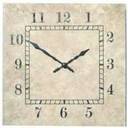

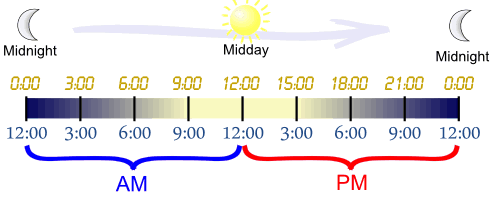
 Imagine your friends say they are leaving for holiday at "midnight" on 12th March, what day should you arrive to say goodbye?
Imagine your friends say they are leaving for holiday at "midnight" on 12th March, what day should you arrive to say goodbye?
Do you get there on the 11th (assuming they leave at the very start of the 12th), or the 12th (assuming they leave at the end of the 12th)?
We measure time using seconds, minutes, hours, days, weeks, months and years.
Clocks measure time.
Clocks
In our world we have digital clocks (they have digits like 0,1,2,3) ...
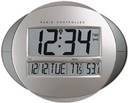
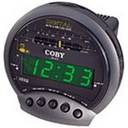




... and analog clocks (they have hands) ...



Digital Clocks
Digital Clocks show us the time using numbers, like this:
Hours : Minutes
Examples:
 |  | |
5 Hours and 8 Minutes
|
9 Hours and 36 Minutes
|
Clocks with Hands
Clocks can also use hands to show us the Hours and Minutes. We call them "analog" clocks.
The Little Hand shows the Hours:
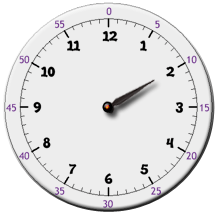 | 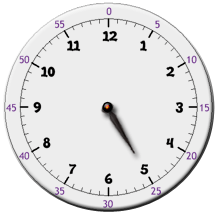 | |
| 2 Hours | 5 Hours |
The Big Hand shows the Minutes:
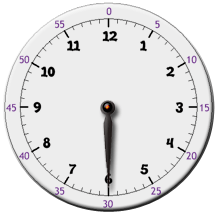 | 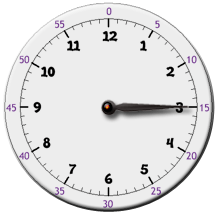 | |
| 30 Minutes or Half-Past | 15 Minutes or Quarter-Past |
Using both the Big Hand and Little Hand lets us know exactly what time it is:
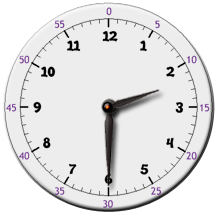 | 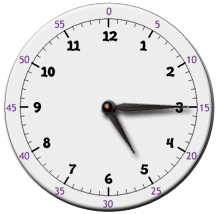 | |
| 2:30 or Half-Past Two | 5:15 or Quarter-Past Five |
Time - AM/PM vs 24 Hour Clock
Normally time is shown as Hours:Minutes
There are 24 Hours in a Day and 60 Minutes in each Hour.
Example: 10:25 means 10 Hours and 25 Minutes
Showing the Time
There are two main ways to show the time: "24 Hour Clock" or "AM/PM":
24 Hour Clock: the time is shown as how many hours and minutes since midnight.
AM/PM (or "12 Hour Clock"): the day is split into:
- the 12 Hours running from Midnight to Noon (the AM hours), and
- the other 12 Hours running from Noon to Midnight (the PM hours).
Like this (try the slider):
24 Hour
AM/PM
14:00
2:00 PM

AM
|
PM
| |
Ante Meridiem*
Latin for "before midday" |
Post Meridiem*
Latin for "after midday" | |
When:
|
Midnight to Noon
|
Noon to Midnight
|
24 Hour Clock:
|
0:00 to 11:59
|
12:00 to 23:59
|
*Is that spelled "Meridiem" or "Meridian"? See here.
Converting AM/PM to 24 Hour Clock
Add 12 to any hour after Noon (and subtract 12 for the first hour of the day):
For the first hour of the day (12 Midnight to 12:59 AM), subtract 12 Hours
Examples: 12 Midnight = 0:00, 12:35 AM = 0:35
From 1:00 AM to 12:59 PM, no change
Examples: 11:20 AM = 11:20, 12:30 PM = 12:30
From 1:00 PM to 11:59 PM, add 12 Hours
Examples: 4:45 PM = 16:45, 11:50 PM = 23:50
Converting 24 Hour Clock to AM/PM
For the first hour of the day (0:00 to 0:59), add 12 Hours, make it "AM"
Examples: 0:10 = 12:10 AM, 0:40 = 12:40 AM
From 1:00 to 11:59, just make it "AM"
Examples: 1:15 = 1:15 AM, 11:25 = 11:25 AM
From 12:00 to 12:59, just make it "PM"
Examples: 12:10 = 12:10 PM, 12:55 = 12:55 PM
From 13:00 to 23:59, subtract 12 Hours, make it "PM"
Examples: 14:55 = 2:55 PM, 23:30 = 11:30 PM
Comparison Chart
Here is a side-by-side comparison of the 24 Hour Clock and AM/PM:
Example: on the hour
|
Example: 10 minutes past
| |||
24 Hour Clock
| AM / PM |
24 Hour Clock
| AM / PM | |
| 0:00 | 12 Midnight | 0:10 | 12:10 AM | |
| 1:00 | 1:00 AM | 1:10 | 1:10 AM | |
| 2:00 | 2:00 AM | 2:10 | 2:10 AM | |
| 3:00 | 3:00 AM | 3:10 | 3:10 AM | |
| 4:00 | 4:00 AM | 4:10 | 4:10 AM | |
| 5:00 | 5:00 AM | 5:10 | 5:10 AM | |
| 6:00 | 6:00 AM | 6:10 | 6:10 AM | |
| 7:00 | 7:00 AM | 7:10 | 7:10 AM | |
| 8:00 | 8:00 AM | 8:10 | 8:10 AM | |
| 9:00 | 9:00 AM | 9:10 | 9:10 AM | |
| 10:00 | 10:00 AM | 10:10 | 10:10 AM | |
| 11:00 | 11:00 AM | 11:10 | 11:10 AM | |
| 12:00 | 12 Noon | 12:10 | 12:10 PM | |
| 13:00 | 1:00 PM | 13:10 | 1:10 PM | |
| 14:00 | 2:00 PM | 14:10 | 2:10 PM | |
| 15:00 | 3:00 PM | 15:10 | 3:10 PM | |
| 16:00 | 4:00 PM | 16:10 | 4:10 PM | |
| 17:00 | 5:00 PM | 17:10 | 5:10 PM | |
| 18:00 | 6:00 PM | 18:10 | 6:10 PM | |
| 19:00 | 7:00 PM | 19:10 | 7:10 PM | |
| 20:00 | 8:00 PM | 20:10 | 8:10 PM | |
| 21:00 | 9:00 PM | 21:10 | 9:10 PM | |
| 22:00 | 10:00 PM | 22:10 | 10:10 PM | |
| 23:00 | 11:00 PM | 23:10 | 11:10 PM | |
Midnight and Noon
"12 AM" and "12 PM" can cause confusion, so we prefer "12 Midnight" and "12 Noon".
What Day is Midnight?
Midnight has another problem: there is nothing to tell us "is this the beginning or ending of the day".

Do you get there on the 11th (assuming they leave at the very start of the 12th), or the 12th (assuming they leave at the end of the 12th)?
It is better to use:
- 11:59 PM or 12:01 AM, or
- 23:59 or 0:01 (24-Hour Clock)
So, when you see something like "offer ends midnight October 15th" tell them to use one minute before or after so there is no confusion!
Subscribe to:
Posts (Atom)





